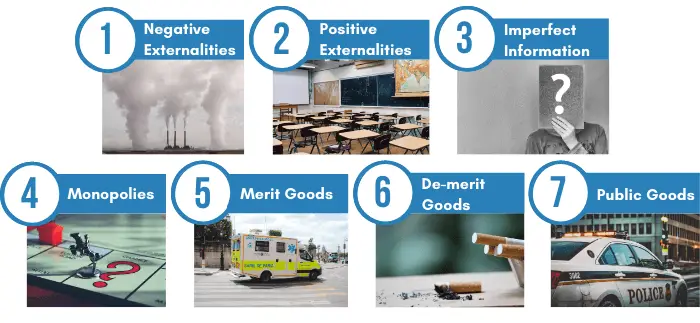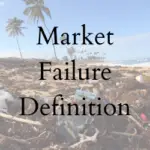Market Failure: Definition, Causes & Examples

What is Market Failure?
Market failure occurs when the true cost of a good is not reflected in the price, resulting in an inefficient allocation of resources. This can happen when a third party benefits but does not pay for that benefit, or when a cost is imposed on a third party without their consent or compensation.
For instance, pollution imposes a cost on society and the environment. However, these external costs are not accounted for in the final price of the good, leading to a net cost to society.
Key Points
- A market failure is where there is an inefficient allocation of resources. This comes either through an undersupply or over-demand, or, where there are externalities.
- When a company does not pass on the cost, both internal and external, onto the final consumer, there is market failure.
- Solutions to market failure include a number of private, government, and voluntarily collective solutions.
Market failure can occur due to various reasons, including externalities and inefficient supply. For instance, the UK’s national healthcare system, which is free at the point of use, experiences a high level of demand that it struggles to meet, resulting in patients facing long waiting times. This leads to an inadequate meeting of demand, making it an example of market failure.
“A market failure occurs when there is an inefficient allocation of resources.”
Supply <> Demand = Market Failure
Market failure can occur due to externalities, where a third party may benefit from a good without directly paying for it. This can lead to an inefficient allocation of resources, as the true cost of the good is not reflected in its price.
For example, the construction of a local park may create positive externalities in the form of recreational activities for people, but the benefits are not directly paid for by the customers. As a result, businesses may under-produce such goods.
Similarly, an educated workforce benefits the entire country, but most individuals would not be willing to pay for everyone else’s education. If education were privately funded, there would likely be a sub-optimal supply and a poorly educated workforce. The same principle can apply to traffic lights and street lamps, as drivers benefit from them but would be unlikely to pay for them directly.
Understanding Market Failure
Market failure occurs when the supply and demand of a good or service do not meet, leading to an inefficient allocation of resources. This can happen when there is an oversupply or undersupply of a product.
Additionally, market failure can occur when the full costs of a good or service are not reflected in the final price, which may impose costs on third parties. Such cases are referred to as externalities.
There are two ways of looking at market failure. Firstly, if the demand for a product is higher than its supply or vice versa, there is a market failure. Secondly, if external costs or benefits are not reflected in the final price, there is also a market failure. These externalities can include positive or negative consequences for third parties.
Examples of Market Failure
Air pollution can cause significant third-party costs through poor air quality which can impact their health. Yet the external cost is not reflected in prices, nor are third parties reimbursed for such. This is known as a negative externality – where the cost is not reflected in the price.
There are also positive externalities, where other parties benefit, but do not pay for it. For example, the government may spend $1 million to build a local park, which creates an external benefit, but a third party may not have spent so much money to receive such a benefit. Resources are therefore allocated inefficiently.
Another example of market failure is in the US dairy market. The industry produces far more than consumers require. Incentivized by subsidies, farmers overproduce dairy products to be eligible for government funds. As a result, most years result in an excessive surplus that governments buy and store. Yet whilst demand in the industry is falling, producers are ramping up production. A clear example of market failure.
Some of the most common examples of market failure include:
- Air and Noise Pollution.
- Education.
- Healthcare.
- Water supply and other utilities.
- Alcohol.
- Policing.
Causes of Market Failure with Examples
Market failure is characterised by disequilibrium and a failure of pricing mechanisms. There are seven main causes which are:

1. Negative Externalities
Air and noise pollution are externalities causing harm to others without consent or compensation. They create costs not reflected in the price, indicating market failure.
Some examples of negative externalities that cause market failure include:
- Traffic
- Litter
- Obesity
- Air Pollution
- Smoking Pollution
2. Positive Externalities
Education is a positive externality, but taxpayers foot the bill. If the benefit is less than the cost, resources are misallocated and taxpayers lose.
Similarly, a $5M park built by the government creates a positive externality, but taxpayers may not have willingly paid for it.
Market failure happens when the cost outweighs the social value of a good.
Some examples of negative externalities that lead to market failure include:
- Education
- Advertising
- Insurance
- New Technology
3. Imperfect Information
Market failures can result from inadequate information available to customers, such as in second-hand car sales. The history of the car, including mileage, accidents, and previous ownership, can affect its price, leading to misallocation of resources.
A car dealer might value a faulty car at $2,000 instead of its actual value of $4,000 due to multiple accidents and faults. They may still sell it for $4,000, causing a market failure for unknowing customers.
Some examples of imperfect information that creates market failure include:
- Healthcare
- Food Ingredients
- Second Hand Cars
- Online Shopping
4. Monopolies
A monopoly, as a market structure, results in an inefficient allocation of resources because it is the only supplier in the market. This leads to higher prices and an undersupply of goods. The lack of competition allows the monopoly to dictate prices, which can lead to diseconomies of scale and other inefficiencies.
An example of this is De Beers’ use of its monopoly power to control the supply of diamonds in the 20th century. This led to customers paying higher prices, resulting in an inefficient allocation of resources.
Some examples of monopolies that create market failures include:
- De Beers
- Water Supply
- Road Construction
5. Merit goods
Goods such as education can provide positive externalities to third parties, which private individuals may not take into account when considering the final price.
For instance, a college education may be worth $100,000 to society and $50,000 to the student. However, the benefit to society is often not factored in, meaning a transaction will only occur if the cost to the student is below $50,000. This applies to any good that generates social benefits that are not fully reflected in the final price.
Some examples of merit goods which create market failure include:
- Fruit and Vegetables
- Education
- School Meals
- Museums
- Libraries
6. De-merit goods
Some products are associated with an underestimated true cost, where customers fail to account for all the negative consequences of consumption. Smoking is a prime example, as it can cause permanent lung damage, but many consumers overlook this fact when deciding whether to smoke.
Addiction is often a key driver of this behavior, as customers who are dependent on a product may be willing to pay more than the true cost. For instance, an alcoholic who craves another drink may have a higher willingness to pay than an average person who is not addicted to alcohol.
Some examples of de-merit goods that create market failure include:
- Smoking
- Drugs
- Alcohol
- Violent Games
7. Public goods
For policing or defense, no private company could efficiently serve the market. Currently, there is no viable way of directly charging the customer for these services. The average taxpayer may not require policing personally, but still benefits from its presence.
In other words, policing creates positive externalities that cannot be fully charged to a victim of a crime, for instance. Thus, while many members of the public may not require the direct assistance of the police, they act as a deterrent and reduce the level of risk for everyone.
Some examples of public goods which create market failures include:
- Police
- Defence
- Law
- Education
How to Solve Market Failures – Responses
Markets sometimes resolve failures. Brand perception solves information issues, and global competition eliminates monopolies by adding market players. Governments intervene at times, but may cause further failures. Which is better: government action or market failure?
Businesses and governments have different ways of responding to market failures. For instance:1. Legislation
Governments create laws to prevent smoking in public places to reduce negative externalities from second-hand smoke. This limits smoker freedom but is beneficial to third parties. Likewise, regulations in the car manufacturing sector add costs to businesses, such as safety and emission regulations. These regulations make cars safer and more eco-friendly but increase the final product cost by billions.
2. Resolving Imperfect Information
The UK and some other governments require manufacturers to provide nutritional information on food packaging to give customers knowledge of the health content. The aim is to overcome imperfect information by providing more information to consumers, allowing them to make informed decisions about their purchases.
3. Subsidies
The US government has historically provided subsidies to farmers to stabilize them from yield fluctuations caused by bad weather. This helps more farmers continue into the next season, providing the nation with food. However, this costs approximately $25 billion per year and encourages overproduction of goods like milk and corn, passing the cost onto the consumer. So although farmers benefit, consumers and tax-payers pay the price.
4. Competition Regulators
The US has the FTC’s Bureau of Competition, which aims to prevent the formation of monopolies, pursue antitrust cases, and promote a competitive business environment. This then helps to prevent market failures from occurring.
5. Government Control
Education is deemed important enough that only the government should provide it, as private firms may not serve the entire population equally. It creates external benefits, such as a more intelligent workforce, but under-performing schools can keep students stuck in their socioeconomic group. Private solutions like School Choice face political resistance.
6. Brand Image
A company’s brand image is often more valuable than its assets as it represents quality and trust to customers. This overcomes misinformation barriers, but trust must be maintained. If McDonald’s had a widespread outbreak of food poisoning, its brand image would be damaged, resulting in significant financial losses.
Related Topics
FAQs
Market failure occurs when there is an oversupply or undersupply; or, where there are costs that are not incorporated into the price, and therefore result in external costs or benefits. In economic jargon, we say there is an inefficient allocation of resources.
Market failures occur when there is an inefficient allocation of resources. For example:
Radio: The station broadcasts to all listeners, but is unable to charge them directly. It can’t tell who is listening or whether they have paid. In turn, this makes it unprofitable to the station as it is unable to finance its operations. As a result, advertising stepped in to address the issue.
Street Lights: A market failure in the fact that it is in demand, but no company would be willing to supply it. For instance, a private firm may supply the lighting, but has no reasonable way of collecting money from customers.
De-merit Goods: There are products whereby the true cost is underestimated. Smoking, for example, causes permanent damage to the lungs, but many consumers undervalue the significance of this in their purchasing decision. Addiction is often a key factor; meaning customers are all too willing to pay over and above the true cost.
There are four main effects of market failure.
1. No Supply: First of all, no business is willing to supply a good or service despite there being demand.
2. Undersupply: The business may be a monopoly and can restrict supply in order to keep prices high. For instance, De Beers diamonds did this during the 20th Century.
3. Oversupply: In the US dairy market, as a result of government subsidies, farmers significantly overproduce milk. As a result, much of it is thrown away.
4. Externalities: These can be both positive and negative. For instance, air pollution is negative and causes an external cost borne by a third party. Whilst a positive externality such as education creates a positive benefit to society that is not paid for directly by the students.
Market failure can be caused by externalities, such as pollution, public goods, such as national defense, market power, such as monopolies or oligopolies, and incomplete or asymmetric information, such as when buyers or sellers have more or less information than the other party.
About Paul
Paul Boyce is an economics editor with over 10 years experience in the industry. Currently working as a consultant within the financial services sector, Paul is the CEO and chief editor of BoyceWire. He has written publications for FEE, the Mises Institute, and many others.

Further Reading
 Market Failure: Definition, Causes & Examples - A market failure is said to occur when there is an inefficient allocation of resources. This can occur when the…
Market Failure: Definition, Causes & Examples - A market failure is said to occur when there is an inefficient allocation of resources. This can occur when the…  Human Capital: Definition, Examples, Pros & Cons - Human capital refers to the skills, habits, and other attributes each person possesses.
Human Capital: Definition, Examples, Pros & Cons - Human capital refers to the skills, habits, and other attributes each person possesses.  Why Free Markets are Important - According to the Collins Dictionary, a free market is an economic system that allows supply and demand to regulate prices,…
Why Free Markets are Important - According to the Collins Dictionary, a free market is an economic system that allows supply and demand to regulate prices,… 